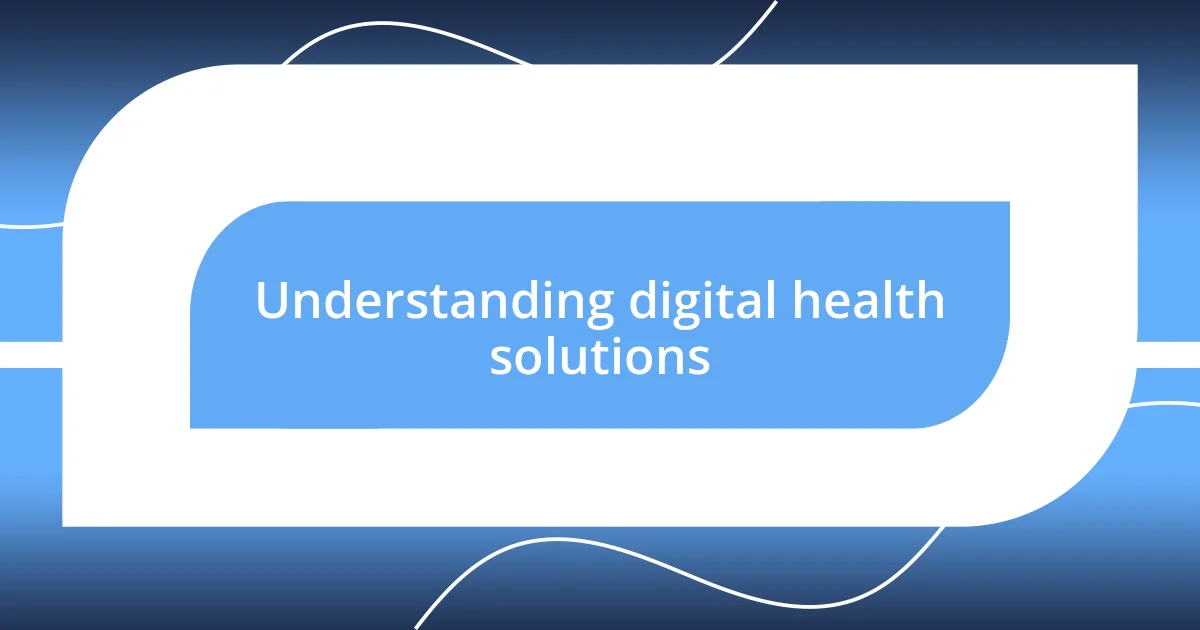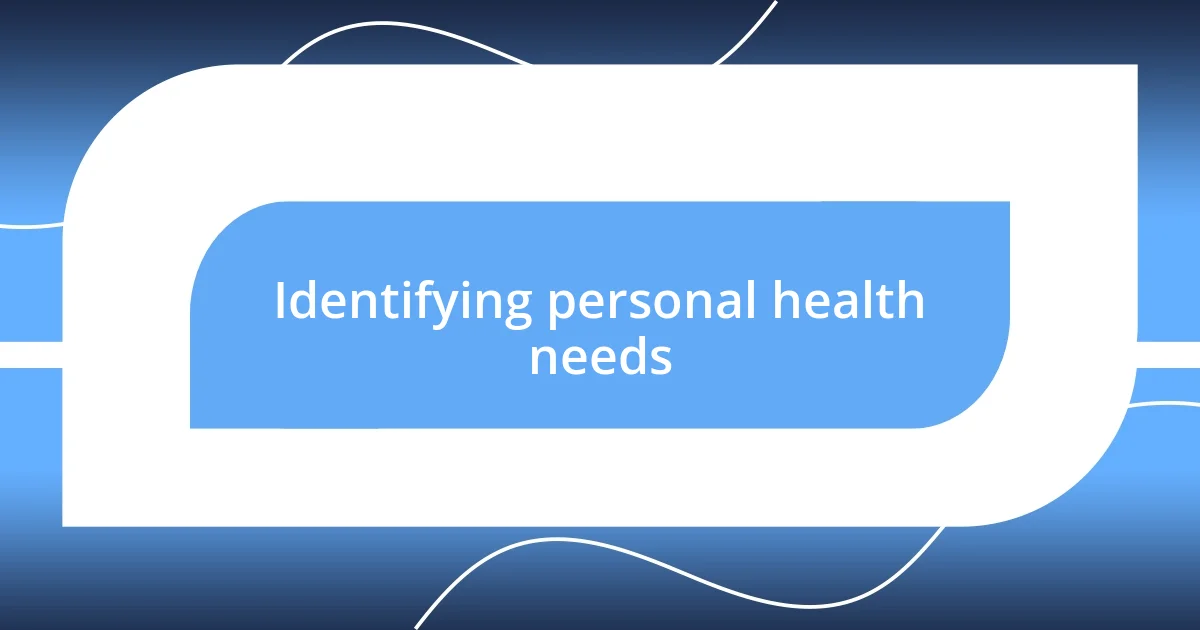Key takeaways:
- Digital health solutions can enhance healthcare by utilizing technology like telemedicine, wearables, and data to empower patients in managing their health.
- Identifying personal health needs through introspection facilitates the selection of appropriate digital tools, transforming users from passive recipients to active participants in their health journeys.
- Measuring success involves not just tracking metrics but understanding their real impact on lifestyle changes, celebrating small victories, and maintaining motivation through community and shared experiences.

Understanding digital health solutions
Digital health solutions encompass a broad range of technologies designed to enhance healthcare delivery and improve health outcomes. I remember the first time I engaged with a telemedicine platform; it felt surreal to consult with my doctor over a screen rather than waiting in a crowded waiting room. Have you ever experienced that shift? It’s a glimpse of how technology can reduce barriers and bring care closer to home.
The landscape of digital health is rapidly evolving, driven by mobile applications, wearables, and remote monitoring. I found myself amazed at how a simple smartwatch could track my heart rate, reminding me to take a moment to breathe and refocus amidst a hectic day. It’s like having a personal health assistant right on my wrist—how incredible is that? These innovations make self-management of health both accessible and intuitive.
What’s truly fascinating is how data plays a central role in these solutions. I often wonder about the power of the information collected—how does it shape our individual health journeys? For instance, when I discovered that the data from my fitness tracker could help my healthcare provider tailor our discussions to my specific needs, it was eye-opening. Understanding digital health solutions isn’t just about the technology; it’s about reimagining the way we interact with our health, ultimately empowering us as patients.

Identifying personal health needs
Identifying personal health needs is the first step I took on my journey with digital health solutions. It involved a mix of introspection and observation, often leading me to moments where I realized my lifestyle choices weren’t aligning with my health goals. One evening, while reflecting on my persistent fatigue, I dug deeper into my routine. This led me to recognize my inconsistent sleep patterns and subpar nutrition, guiding me toward the right digital tools to address those issues.
- Assess your current health status: List out any chronic conditions or symptoms you experience regularly.
- Reflect on your lifestyle habits: Think about your sleep, diet, exercise, and stress levels.
- Set specific health goals: Whether you want to lose weight, improve sleep quality, or manage anxiety, defining these goals helps in selecting appropriate tools.
- Consider your personal preferences: Identify what methods resonate with you—do you prefer apps, wearables, or online communities for support?
In my case, the simple act of journaling helped illuminate patterns in my habits that I previously overlooked. It was both empowering and humbling to confront these truths, all while envisioning how digital health solutions could be tailored to meet my unique challenges. As I moved forward, I felt more like an active participant in my health journey rather than a passive recipient of care.

Exploring available digital tools
I remember when I first started exploring digital health tools; it felt like wandering into a new world filled with possibilities. There are countless applications and devices, each offering unique features tailored to different needs. For instance, some apps focus on tracking mental health through mood logs, while others might specialize in fitness planning. I experimented with a couple of these and found that what works for one person may not work for another, which is such a valuable takeaway. Have you ever tried multiple tools to find the right fit?
As I delved deeper into the options, I found myself drawn to tools that allowed for customization. I recall downloading an app that not only monitored my physical activity but also let me set goals for hydration and mindfulness. This approach felt holistic to me; it wasn’t just about counting steps but nurturing my entire well-being. The experience truly illustrated how these digital tools can adapt to personal circumstances. Which features do you believe would resonate most with your lifestyle?
To simplify the exploration process, I created a small comparison table for some of the digital health solutions I’ve encountered, highlighting their key features:
| Tool type | Key features |
|---|---|
| Fitness apps | Activity tracking, goal setting, community challenges |
| Mental health apps | Mood tracking, guided meditations, therapy resources |
| Wearables | Health monitoring, notifications, sleep insights |

Evaluating platform features and benefits
When evaluating platform features and benefits, I found it essential to prioritize what truly mattered to me. For example, while experimenting with a nutrition tracking app, I quickly discovered that user-friendliness significantly affected my engagement. I remember struggling initially with an overly complicated interface—if a tool feels like a chore, it’s unlikely to become a daily habit, right?
Beyond usability, I also focused on how each platform aligned with my health goals. I vividly recall the moment I realized that a sleep-tracking app not only provided data but also offered insights on how to improve my sleep routine. That combination felt empowering. It wasn’t just about collecting numbers; the actionable advice transformed my approach to rest in ways I hadn’t anticipated. Have you ever noticed how certain features can elevate your commitment to health?
Moreover, I discovered the power of community features within these platforms. Participating in challenges that allowed me to share experiences with others brought a sense of camaraderie I hadn’t expected. There’s something uplifting about connecting with someone who shares similar struggles and triumphs. The support I received felt rewarding and motivated me to keep pressing forward—wasn’t it fascinating to find that a digital platform could foster such genuine human connection?

Integrating solutions into daily routines
Integrating digital health solutions into my daily routine wasn’t always straightforward, but finding my rhythm was key. Initially, I set a timer on my phone to remind me to check my wellness apps. It felt a bit forced at first, but slowly that gentle nudge turned into a habit. Have you ever noticed how reminders can feel like little cheerleaders in your daily life?
One of the most effective strategies I adopted was weaving these tools into existing habits. For example, I decided to log my meals right after breakfast instead of waiting until the end of the day. This small adjustment not only kept me accountable but also provided instant feedback on my food choices. When were you last surprised by what you ate at lunch?
There were days when I felt overwhelmed, and that’s when I learned the value of simplicity. I’d pick one key feature from an app and focus on it rather than getting lost in all the bells and whistles. I remember when I solely focused on hydration using a drink-tracking app, pairing it with my morning coffee routine. That approach made it feel less like a task and more like a seamless part of my day. Have you ever found success by simplifying your process?

Overcoming common digital health challenges
Navigating the common challenges in digital health felt like a journey of trial and error for me. One that stands out was grappling with information overload; there were times I felt paralyzed by the abundance of features available. I vividly recall a week where each new notification was a guilt trip. To combat this, I made a conscious effort to limit my engagement and focused on just a couple of key metrics that truly mattered to me. Have you found that narrowing down your focus can help ease that overwhelming feeling?
Another hurdle I faced was technical glitches, which I had to confront head-on. There were instances when progress tracking was derailed by app crashes or syncing issues, but I quickly learned the importance of reaching out for support. Reporting those bugs didn’t just fix my experience; it fostered a sense of ownership in the platforms I was using. Have you ever felt empowered by taking those small steps to troubleshoot your journeys?
Then there was the issue of motivation, especially when initial enthusiasm waned. I remember hitting a slump just after my first month of using a fitness app. In those moments, I revisited my goals and reassessed what drove me. Connecting with user stories and success stories within the app reignited my passion and reminded me that I wasn’t alone in this endeavor. Isn’t it incredible how storytelling can reignite our motivation?

Measuring success and outcomes
Measuring the success of digital health solutions isn’t just about tracking numbers; it’s about understanding their impact on my life. I recall a pivotal moment when I hit my hydration goals consistently for two weeks. It wasn’t merely a statistic; it was the energy boost I felt throughout the day that truly signified success. Have you experienced that exhilarating moment when your efforts align with tangible results?
Equally important is reflecting on how these metrics resonate with personal health goals. After a month of using a stress management app, I decided to assess not only my anxiety levels but also my overall well-being. I realized that the app’s insights helped me identify patterns in my daily habits that contributed to stress. In that moment, I understood that success lies deeper than surface-level data. How often do we take the time to dig beneath the numbers?
Celebrating small victories plays a crucial role in measuring outcomes too. I remember when I logged my first week of consistent sleep tracking and noticed an improvement in my mood the following mornings. Sharing that success with friends turned it into a collective celebration, reinforcing my commitment to my health journey. How do you recognize and celebrate your progress amidst the daily grind?














